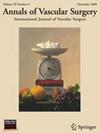下肢搭桥手术后早发手术部位感染的特征。
IF 1.4
4区 医学
Q3 PERIPHERAL VASCULAR DISEASE
引用次数: 0
摘要
背景:手术部位感染(SSI)是下肢搭桥(LEB)手术后最常见的并发症。SSI 会导致严重的患者发病率和医疗支出,准确检测 SSI 仍是减少 SSI 的重要一步。在这项研究中,我们旨在了解接受下肢搭桥手术的患者中早发 SSI 的特征:回顾性查询了 2018-2022 年间三家医院进行的所有 LEB 手术的机构医疗记录。根据疾病预防控制中心的定义,纳入了术后 90 天内的所有 SSI,并将其分为早期 SSI(术后 7 天内)、标准 SSI(8-30 天)或延迟 SSI(31-90 天)。南安普顿分级表用于对感染严重程度进行分层(2 级,红斑;3 级,红斑伴浆液性引流;4 级,红斑伴脓性引流;或 5 级,严重伤口坏死)。数据分析采用单变量检验和逻辑回归分析:在为期五年的研究期间,共进行了517例LEB手术。中位随访时间为 18.5 个月。分别有2.9%(15人)、15.1%(78人)和4.6%(24人)的患者确诊为早期、标准和延迟发生的SSI。与标准组和延迟发病组相比,早发 SSI 患者更多不吸烟(26.7% vs 3.9% vs 8.3%,P=0.03),且合并症发生率较低。早发型 SSI 最常表现为南安普敦 2 级(60.0%)或 5 级(20.0%)感染;而标准型和延迟型 SSI 在 2 级(30.4%)、3 级(41.2%)和 4 级(21.6%)感染中的分布更为均匀(P=0.002)。在早发型 SSI 组别中,最常见的分离菌是革兰氏阴性杆菌(20.0%)。相比之下,多微生物感染(19.6%)和革兰阳性球菌(14.7%)在标准组和延迟发病组中最为常见(P=0.04)。与标准组和延迟发病组相比,早期发病 SSI 组住院时间更长(11 天 vs 6 天 vs 8 天,p=0.02),30 天再入院率更低(13.3% vs 59.0% vs 45.8%,p=0.005)。在多变量分析中,主动吸烟(危险比 [HR] 0.15,95% 置信区间 [CI],0.02-0.98,P=0.035)、曾经吸烟(HR 0.08,95% CI,0.01-0.71,P=0.02)、冠状动脉疾病(HR 0.15,95% CI,0.03-0.83,P=0.03)和高血压(HR 0.13,95% CI,0.03-0.68,P=0.02)与标准型和延迟型 SSI 患者相比,早发感染风险更低:结论:LEB手术后早发性SSI具有独特的临床表现,影响更健康的患者,而且与标准和延迟发性SSI相比,感染的毒力更强。本文章由计算机程序翻译,如有差异,请以英文原文为准。
Characterizing Early-Onset Surgical Site Infection After Lower Extremity Bypass Surgery
Background
Surgical site infections (SSI) are the most common complication following lower extremity bypass (LEB) surgery. SSIs contribute to significant patient morbidity and healthcare expenditure, and accurate detection of SSIs remains an important step in reduction efforts. In this study, we aimed to characterize early-onset SSIs among patients undergoing LEB surgery.
Methods
Institutional medical records were retrospectively queried for all LEB operations performed across 3 hospitals from 2018 to 2022. All SSIs within a 90-day postoperative period were included, per CDC definition, and categorized as early- (within 7 days of operation), standard- (8–30 days), or delayed-onset (31–90 days). The Southampton grading scale was used to stratify the severity of infection (grade 2, erythema; grade 3, erythema with serous drainage; grade 4; erythema with purulent drainage; or grade 5, severe wound necrosis). Data were analyzed using univariate tests and logistic regression analysis.
Results
A total of 517 LEB operations were performed over the 5-year study period. Median follow-up period was 18.5 months. Early-, standard-, and delayed-onset SSIs were diagnosed in 2.9% (n = 15), 15.1% (n = 78), and 4.6% (n = 24) of the patients, respectively. Compared with standard- and delayed-onset groups, patients with early-onset SSIs were more frequently nonsmokers (26.7% vs. 3.9% vs. 8.3%, P = 0.03) and had lower prevalence of comorbidities. Early-onset SSIs most frequently presented as Southampton grade 2 (60.0%) or grade 5 (20.0%) infections, whereas standard- and delayed-onset SSIs were more evenly distributed among grade 2 (30.4%), grade 3 (41.2%), and grade 4 (21.6%) presentations (P = 0.002). The most commonly isolated organisms among the early-onset SSI group were Gram-negative rods (20.0%). In comparison, polymicrobial infections (19.6%) and Gram-positive cocci (14.7%) were most common among standard- and delayed-onset groups (P = 0.04). The early-onset SSI group experienced a longer index hospitalization (11 vs. 6 vs. 8 days, P = 0.02) and lower 30-day readmission rates (13.3% vs. 59.0% vs. 45.8%, P = 0.005) compared with standard- and delayed-onset groups. On multivariate analysis, active smoking (hazard ratio [HR] 0.15, 95% confidence interval [CI], 0.02–0.98, P = 0.035), former smoking (HR 0.08, 95% CI, 0.01–0.71, P = 0.02), coronary artery disease (HR 0.15, 95% CI, 0.03–0.83, P = 0.03), and hypertension (HR 0.13, 95% CI, 0.03–0.68, P = 0.02) were associated with a lower risk of early-onset infection, when compared with patients suffering standard- and delayed-onset SSIs.
Conclusions
Early-onset SSIs after LEB surgery have a distinct clinical presentation, impact healthier patients, and are associated with more virulent organisms compared with standard- and delayed-onset SSIs.
求助全文
通过发布文献求助,成功后即可免费获取论文全文。
去求助
来源期刊
CiteScore
3.00
自引率
13.30%
发文量
603
审稿时长
50 days
期刊介绍:
Annals of Vascular Surgery, published eight times a year, invites original manuscripts reporting clinical and experimental work in vascular surgery for peer review. Articles may be submitted for the following sections of the journal:
Clinical Research (reports of clinical series, new drug or medical device trials)
Basic Science Research (new investigations, experimental work)
Case Reports (reports on a limited series of patients)
General Reviews (scholarly review of the existing literature on a relevant topic)
Developments in Endovascular and Endoscopic Surgery
Selected Techniques (technical maneuvers)
Historical Notes (interesting vignettes from the early days of vascular surgery)
Editorials/Correspondence

 求助内容:
求助内容: 应助结果提醒方式:
应助结果提醒方式:


